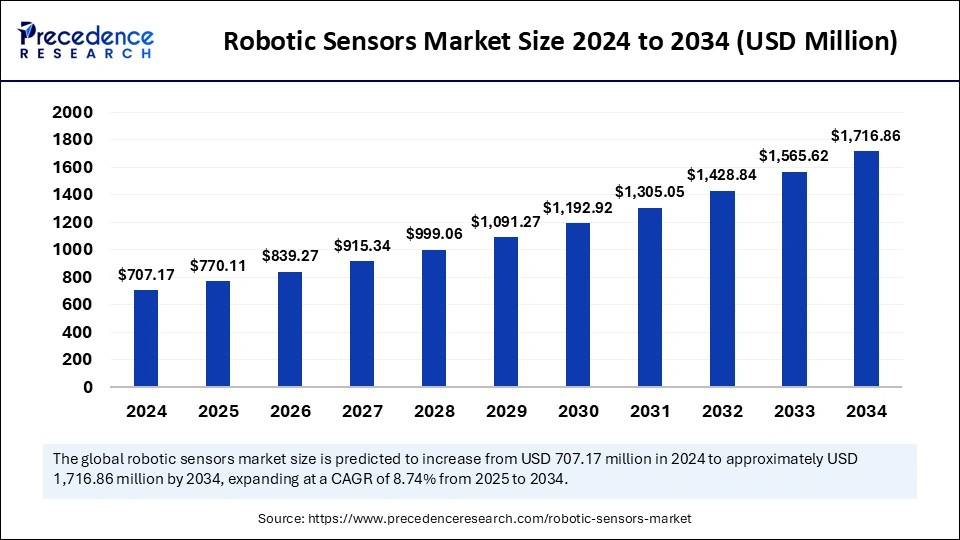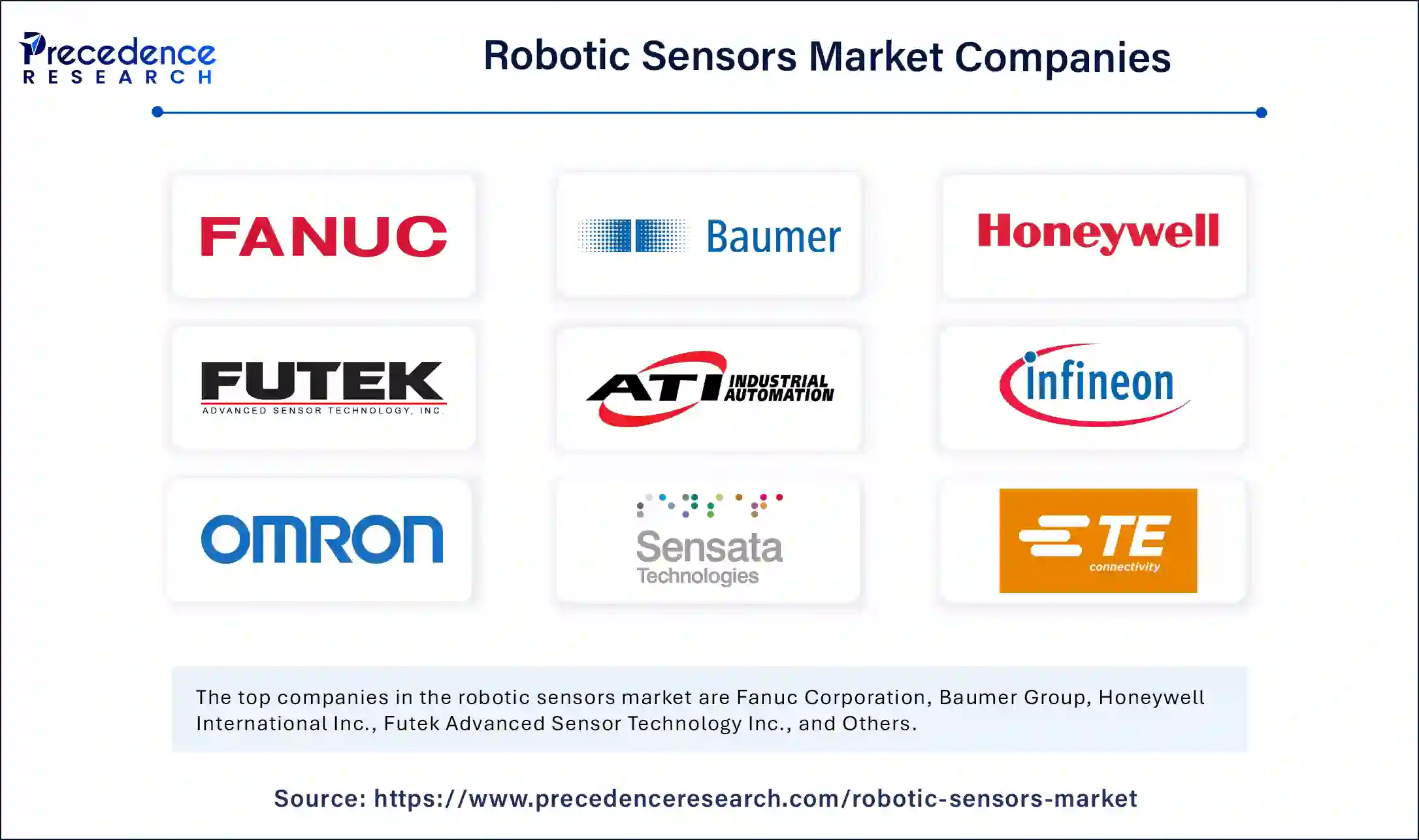Robotic Sensors Market Size to Gain USD 1,716.86 Million by 2034
Robotic Sensors Market Size and Forecast 2025 to 2034
The global robotic sensors market size is estimated to gain around USD 1,716.86 million by 2034, increasing from USD 707.17 million in 2024, with a CAGR of 8.74%.

Get a Free Sample Copy of the Report@ https://www.precedenceresearch.com/sample/5827
Robotic Sensors Market Key Insights
-
The robotic sensors market was dominated by Asia Pacific in 2024.
-
North America is expected to witness rapid growth during the forecast period.
-
The largest share by sensor type in 2024 was held by vision sensors.
-
Force/torque sensors are anticipated to grow at the fastest rate during the forecast period.
-
Industrial robots led the market in 2024 in terms of application.
-
Healthcare robots are predicted to grow significantly in the coming years.
-
MEMS-based technology contributed the largest share in the market in 2024.
-
The optical sensor technology segment is expected to show significant growth.
-
Analog interfaces dominated the market in 2024.
-
The digital interface segment is expected to experience the highest CAGR during the forecast period.
-
The mobile robots segment accounted for a significant market share in 2024.
-
The industrial robots platform is expected to see notable growth in the next few years.
Transforming Robotic Sensors: The Role of AI in Enhancing Performance and Efficiency
AI plays a pivotal role in the advancement of robotic sensors, significantly enhancing their capabilities, performance, and overall efficiency in various applications. One of the primary contributions of AI is its ability to improve sensor data processing. AI algorithms, particularly machine learning and deep learning, enable robotic sensors to process vast amounts of data in real time, allowing robots to make quick decisions based on environmental changes. For example, vision sensors combined with AI can help robots recognize objects, detect anomalies, and navigate complex environments with higher precision and adaptability.
AI also enhances the accuracy and functionality of force/torque sensors by enabling robots to “feel” and adjust to different pressures during tasks, allowing for more delicate and precise operations in industries like manufacturing, healthcare, and assembly. AI-driven predictive maintenance is another key role, where it helps monitor the performance of robotic sensors, anticipating potential failures and minimizing downtime by scheduling timely repairs.
Furthermore, AI aids in sensor fusion, where data from multiple sensors (such as vision, force, and proximity sensors) is combined to provide a more comprehensive understanding of the robot’s surroundings, leading to better decision-making and task execution. Through these innovations, AI not only improves the efficiency of robotic sensors but also enables robots to operate autonomously in increasingly complex environments.
Robotic Sensors Market Growth Factors
-
Rising Demand for Automation: As industries such as manufacturing, logistics, automotive, and healthcare continue to embrace automation, the demand for robotic sensors is increasing. Robotic sensors are essential in enabling robots to perform tasks with greater accuracy, precision, and efficiency, which is fueling their adoption in automated processes.
-
Technological Advancements: Innovations in sensor technologies, such as advancements in vision, force/torque, and proximity sensors, are improving the performance of robotic systems. The development of more sophisticated sensors with enhanced capabilities, like increased sensitivity and faster data processing, is opening up new applications for robots, driving market growth.
-
AI and Machine Learning Integration: The integration of AI and machine learning with robotic sensors is enabling more intelligent and autonomous robots. AI algorithms help robots interpret sensor data in real-time, allowing them to make decisions and adapt to dynamic environments. This has significantly expanded the use of robots in complex tasks that require high levels of precision and flexibility.
-
Growth in Industrial Automation: The increasing adoption of industrial robots, particularly in manufacturing, is one of the primary factors driving the demand for robotic sensors. Robots equipped with sensors are able to perform quality control, assembly, and material handling tasks more efficiently, leading to reduced costs and higher production speeds in industries like automotive, electronics, and consumer goods.
-
Healthcare and Service Robotics: The use of robots in healthcare is rapidly expanding, particularly in areas like surgery, rehabilitation, and patient monitoring. Robotic sensors are critical in providing the precise feedback needed for these applications. Additionally, the rise of service robots, such as delivery robots and cleaning robots, in sectors like retail and hospitality, is increasing the demand for advanced robotic sensors.
-
Improved Sensor Accuracy and Sensitivity: With advancements in sensor materials and design, the accuracy, sensitivity, and reliability of robotic sensors have improved. This has made them more suitable for high-precision applications, such as in research, surgery, and autonomous vehicles, where even small errors can have significant consequences.
-
Cost Reduction in Sensor Technology: As sensor technology continues to evolve and scale, the cost of sensors has been gradually decreasing. This makes robotic sensors more accessible to a broader range of industries and smaller companies, expanding the market’s reach.
-
Emerging Applications in Autonomous Vehicles and Drones: The rise of autonomous vehicles and drones is another significant growth factor for robotic sensors. These technologies rely heavily on sensors like LIDAR, cameras, and radar to navigate and interact with their environments, driving demand for advanced sensor solutions.
-
Government Initiatives and Investments: Governments worldwide are investing in robotics and automation to drive economic growth, enhance productivity, and address labor shortages. This investment supports the development of robotic sensors and encourages innovation in the field, leading to further market expansion.
Market Scope
| Report Coverage | Details |
| Market Size by 2034 | USD 1,716.86 Million |
| Market Size in 2025 | USD 770.11 Million |
| Market Size in 2024 | USD 707.17 Million |
| Market Growth Rate from 2025 to 2034 | CAGR of 8.74% |
| Dominating Region | Asia Pacific |
| Fastest Growing Region | North America |
| Base Year | 2024 |
| Forecast Period | 2025 to 2034 |
| Segments Covered | Sensor Type, Application, Technology, Interface, Platform, and Regions. |
| Regions Covered | North America, Europe, Asia-Pacific, Latin America, and the Middle East & Africa. |
Market Dynamics
Market Drivers
One of the primary drivers of the robotic sensors market is the rapid adoption of industrial automation. Manufacturers are increasingly relying on robots to boost productivity, maintain quality, and reduce operational costs. Robotic sensors are critical for these systems to perform complex tasks with precision and safety. Technological advancements such as AI and machine learning integration have further enhanced the capabilities of robotic sensors, enabling real-time data processing and autonomous decision-making. Additionally, the growing demand for service and healthcare robots, particularly post-pandemic, is propelling the market forward, as these robots require sophisticated sensors for patient monitoring, assistance, and mobility support.
Market Opportunities
The robotic sensors market presents numerous opportunities, particularly with the rise of emerging applications such as autonomous vehicles, smart factories, and agriculture automation. In these fields, sensors such as LIDAR, vision sensors, and proximity detectors are vital for effective operation. The integration of AI with robotic sensors opens up new possibilities in predictive maintenance, adaptive learning, and enhanced human-robot collaboration. Moreover, the development of cost-efficient and compact sensors is making advanced robotic technologies more accessible to small and medium-sized enterprises. The increasing demand in sectors like logistics, e-commerce, and smart homes also provides new growth avenues for sensor manufacturers and developers.
Market Challenges
Despite strong growth potential, the robotic sensors market faces several challenges. One major concern is the high cost of advanced sensor technologies, which can be a barrier for small businesses and startups. Additionally, sensor integration in complex robotic systems can be technically demanding and time-consuming, requiring specialized expertise. There are also issues related to data accuracy and sensor reliability, especially in unpredictable or harsh environments. Furthermore, interoperability between different sensor systems and data processing platforms remains a challenge that hinders seamless deployment in multi-vendor setups. Security and privacy concerns related to data collected by robotic sensors also pose regulatory and ethical challenges that the industry must address.
Regional Insights
Regionally, Asia Pacific dominated the global robotic sensors market in 2024, driven by rapid industrialization, increasing investments in robotics, and the presence of key manufacturing hubs like China, Japan, and South Korea. The region’s focus on automation in sectors such as electronics, automotive, and logistics contributes significantly to the market’s growth. North America is expected to witness the fastest growth during the forecast period, fueled by strong investments in AI-driven robotics, technological innovations, and the expanding use of robots in healthcare and defense. Europe also holds a substantial share due to the presence of advanced manufacturing facilities and stringent regulations that promote the use of robotics for safety and efficiency. Meanwhile, emerging markets in Latin America and the Middle East are gradually adopting robotic technologies, offering future growth potential for robotic sensor applications.
Recent Developments
- In June 2024, an innovative tactile sensor which is omnidirectional for robotic hands was launched by ETRI which detects pressure exerted by nay entity from any direction. These sensors further offer high precision and longevity as they are integrated with LED indicators and flexible air chambers.
- In June 2024, in India a leading player-HIKROBOT unveiled machine vision photoelectric sensors in India to strengthen its portfolio of robot sensors. It helps upgrade features of robotic sensors, like machine vision, resistance to climatic factors, and long-range detection.
Robotic Sensors Market Companies

- Fanuc Corporation
- Baumer Group
- Honeywell International Inc.
- Futek Advanced Sensor Technology Inc.
- ATI Industrial Automation Inc.
- Infineon Technologies
- Omron Corporation
- Sensata Technologies Inc.
- TE Connectivity Ltd.
- Tekscan Inc.
Segments Covered in the Report
By Sensor Type
- Vision Sensors
- Force/Torque Sensors
- Inertial Measurement Units
- Encoders
- Laser Sensors
- Ultrasonic Sensors
By Application
- Industrial Robotics
- Healthcare Robotics
- Military and Defence Robotics
- Consumer Robotics
- Commercial Robotics
By Technology
- MEMS-based
- Optical
- Capacitive
- Inductive
- Piezoelectric
By Interface
- Analog
- Digital
- Wireless
- Fieldbus
By Robotic Platform
- Mobile Robots
- Industrial Robots
- Collaborative Robots
- Humanoid Robots
By Region
- North America
- Europe
- Asia Pacific
- Latin America
- Middle East and Africa (MEA)
Also Read: High Voltage Direct Current (HVDC) Capacitor Market
Ready for more? Dive into the full experience on our website@ https://www.precedenceresearch.com/
